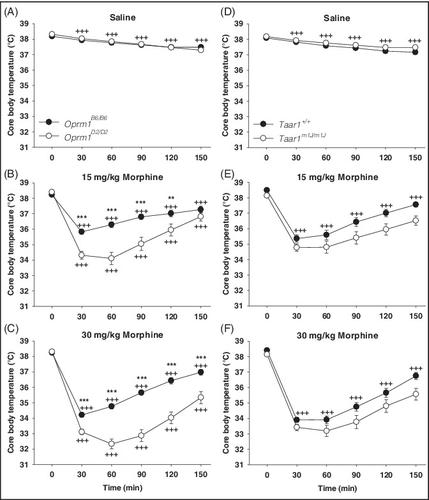当前位置:
X-MOL 学术
›
Genes Brain Behav.
›
论文详情
Our official English website, www.x-mol.net, welcomes your
feedback! (Note: you will need to create a separate account there.)
Differential genetic risk for methamphetamine intake confers differential sensitivity to the temperature-altering effects of other addictive drugs.
Genes, Brain and Behavior ( IF 2.4 ) Pub Date : 2020-01-10 , DOI: 10.1111/gbb.12640 John R K Mootz 1 , Nicholas B Miner 1 , Tamara J Phillips 1, 2
Genes, Brain and Behavior ( IF 2.4 ) Pub Date : 2020-01-10 , DOI: 10.1111/gbb.12640 John R K Mootz 1 , Nicholas B Miner 1 , Tamara J Phillips 1, 2
Affiliation

|
Mice selectively bred for high methamphetamine (MA) drinking (MAHDR), compared with mice bred for low MA drinking (MALDR), exhibit greater sensitivity to MA reward and insensitivity to aversive and hypothermic effects of MA. Previous work identified the trace amine‐associated receptor 1 gene (Taar1 ) as a quantitative trait gene for MA intake that also impacts thermal response to MA. All MAHDR mice are homozygous for the mutant Taar1
m1J allele, whereas all MALDR mice possess at least one copy of the reference Taar1
+ allele. To determine if their differential sensitivity to MA‐induced hypothermia extends to drugs of similar and different classes, we examined sensitivity to the hypothermic effect of the stimulant cocaine, the amphetamine‐like substance 3,4‐methylenedioxymethamphetamine (MDMA), and the opioid morphine in these lines. The lines did not differ in thermal response to cocaine, only MALDR mice exhibited a hypothermic response to MDMA, and MAHDR mice were more sensitive to the hypothermic effect of morphine than MALDR mice. We speculated that the μ‐opioid receptor gene (Oprm1 ) impacts morphine response, and genotyped the mice tested for morphine‐induced hypothermia. We report genetic linkage between Taar1 and Oprm1 ; MAHDR mice more often inherit the Oprm1
D2 allele and MALDR mice more often inherit the Oprm1
B6 allele. Data from a family of recombinant inbred mouse strains support the influence of Oprm1 genotype, but not Taar1 genotype, on thermal response to morphine. These results nominate Oprm1 as a genetic risk factor for morphine‐induced hypothermia, and provide additional evidence for a connection between drug preference and drug thermal response.
中文翻译:

甲基苯丙胺摄入量的不同遗传风险导致对其他成瘾药物的温度改变作用的敏感性不同。
与低甲基苯丙胺 (MA) 饮酒 (MAHDR) 培育的小鼠相比,选择性培育的高甲基苯丙胺 (MA) 饮酒 (MAHDR) 小鼠对 MA 奖励更敏感,而对 MA 的厌恶和低温效应不敏感。先前的工作确定了痕量胺相关受体 1 基因 ( Taar1 ) 作为 MA 摄入的数量性状基因,它也会影响对 MA 的热反应。所有 MAHDR 小鼠对于突变Taar1 m1J等位基因都是纯合的,而所有 MALDR 小鼠都拥有至少一个参考Taar1 +等位基因的副本。为了确定他们对 MA 引起的低温的差异敏感性是否扩展到类似和不同类别的药物,我们检查了对兴奋剂可卡因、苯丙胺样物质 3,4-亚甲二氧基甲基苯丙胺 (MDMA) 和阿片类吗啡的低温效应的敏感性在这些行中。这些品系对可卡因的热反应没有差异,只有 MALDR 小鼠表现出对 MDMA 的低温反应,并且 MAHDR 小鼠比 MALDR 小鼠对吗啡的低温效应更敏感。我们推测μ-阿片受体基因( Oprm1 )影响吗啡反应,并对吗啡引起的体温过低测试的小鼠进行了基因分型。我们报告了Taar1和Oprm1之间的遗传连锁; MAHDR 小鼠更常遗传Oprm1 D2等位基因,而 MALDR 小鼠更常遗传Oprm1 B6等位基因。来自重组近交系小鼠品系家族的数据支持Oprm1基因型(而非Taar1基因型)对吗啡热反应的影响。 这些结果将Oprm1指定为吗啡引起的体温过低的遗传风险因素,并为药物偏好与药物热反应之间的联系提供了额外的证据。
更新日期:2020-01-10
中文翻译:

甲基苯丙胺摄入量的不同遗传风险导致对其他成瘾药物的温度改变作用的敏感性不同。
与低甲基苯丙胺 (MA) 饮酒 (MAHDR) 培育的小鼠相比,选择性培育的高甲基苯丙胺 (MA) 饮酒 (MAHDR) 小鼠对 MA 奖励更敏感,而对 MA 的厌恶和低温效应不敏感。先前的工作确定了痕量胺相关受体 1 基因 ( Taar1 ) 作为 MA 摄入的数量性状基因,它也会影响对 MA 的热反应。所有 MAHDR 小鼠对于突变Taar1 m1J等位基因都是纯合的,而所有 MALDR 小鼠都拥有至少一个参考Taar1 +等位基因的副本。为了确定他们对 MA 引起的低温的差异敏感性是否扩展到类似和不同类别的药物,我们检查了对兴奋剂可卡因、苯丙胺样物质 3,4-亚甲二氧基甲基苯丙胺 (MDMA) 和阿片类吗啡的低温效应的敏感性在这些行中。这些品系对可卡因的热反应没有差异,只有 MALDR 小鼠表现出对 MDMA 的低温反应,并且 MAHDR 小鼠比 MALDR 小鼠对吗啡的低温效应更敏感。我们推测μ-阿片受体基因( Oprm1 )影响吗啡反应,并对吗啡引起的体温过低测试的小鼠进行了基因分型。我们报告了Taar1和Oprm1之间的遗传连锁; MAHDR 小鼠更常遗传Oprm1 D2等位基因,而 MALDR 小鼠更常遗传Oprm1 B6等位基因。来自重组近交系小鼠品系家族的数据支持Oprm1基因型(而非Taar1基因型)对吗啡热反应的影响。 这些结果将Oprm1指定为吗啡引起的体温过低的遗传风险因素,并为药物偏好与药物热反应之间的联系提供了额外的证据。











































 京公网安备 11010802027423号
京公网安备 11010802027423号